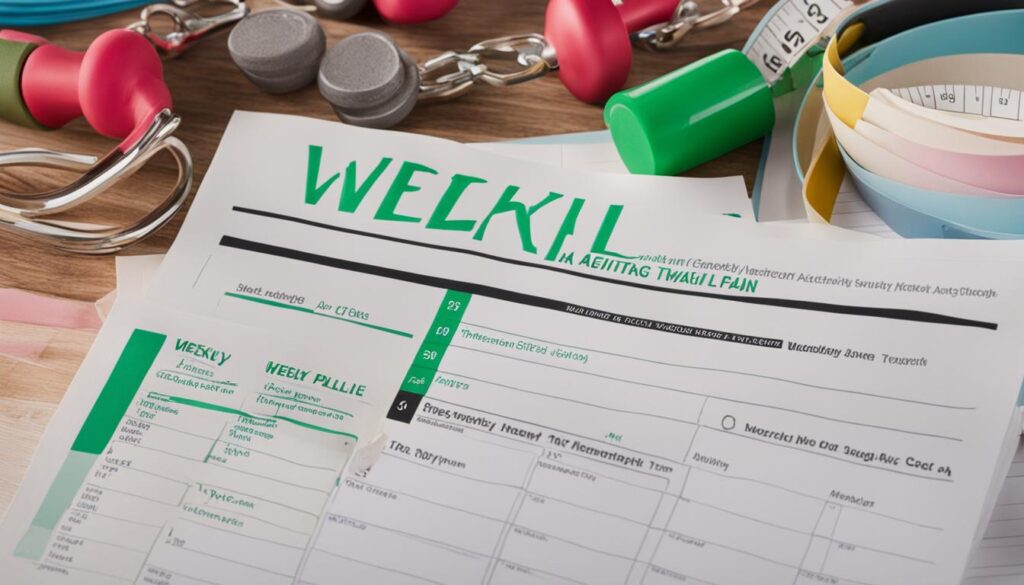Setting weight loss goals that support healthy progress is crucial for long-lasting results. When it comes to weight loss, implementing SMART goals is an effective strategy. SMART stands for Specific, Measurable, Achievable, Relevant, and Time-Bound, and it provides a framework to outline the how and when of achieving weight loss. By setting SMART goals, individuals can create a clear roadmap towards their desired weight loss goals.
Key Takeaways:
- SMART weight loss goals are specific, measurable, achievable, relevant, and time-bound intentions to lose weight.
- Healthy weight loss is defined as losing one pound per week, as anything faster can lead to health problems.
- Before starting a weight loss journey, it is important to clarify the reasons behind the goal and understand the role of muscle mass and nutrition in the process.
- Setting specific, measurable, achievable, relevant, and time-bound goals is crucial for weight loss success (check out my post on weight loss success here).
- SMART goal setting provides a practical approach to achieving and maintaining weight loss goals.
What Are SMART Weight Loss Goals?
Setting weight loss goals is essential for achieving healthy and long-lasting weight loss results (check this post out). However, simply stating a desire to lose weight is too vague. To ensure success, it’s important to establish SMART weight loss goals that are specific, measurable, achievable, relevant, and time-bound.
SMART weight loss goals provide a clear roadmap for your weight loss journey, helping you stay focused and motivated. By implementing these goals, you can effectively track your progress and make necessary adjustments along the way.
Let’s dive deeper into each component of SMART weight loss goals:
Specific
A specific weight loss goal is well-defined and clearly outlines what you want to achieve. Instead of vaguely aiming to “lose weight,” set a specific target like “lose 10 pounds” or “reduce body fat by 5%”. This specificity allows you to track your progress more accurately.
Measurable
A measurable weight loss goal is one that can be quantified or measured. By including specific numbers or metrics in your goal, such as pounds, inches, or clothing sizes, you can objectively assess your progress and celebrate milestones along the way.
Achievable
An achievable weight loss goal is realistic and within your reach. It is important to set goals that you believe you can accomplish, considering factors such as your current physical condition, lifestyle, and available resources. This ensures that you stay motivated and avoid setting yourself up for disappointment.
Relevant
A relevant weight loss goal aligns with your overall health and well-being. It takes into account your individual needs, preferences, and circumstances. Your weight loss goal should be meaningful to you and contribute to improving your overall health and quality of life.
Time-Bound
A time-bound weight loss goal has a specific deadline or timeframe. By setting a target date for achieving your goal, you create a sense of urgency and accountability. This helps you stay on track and prevents procrastination.
Implementing SMART weight loss goals empowers you with a purposeful and structured approach to weight loss. It ensures that you are setting yourself up for success and adopting healthy habits along the way.
With a clear understanding of what SMART weight loss goals are, you’ll be ready to embark on your weight loss journey with confidence and determination. In the next section, we’ll explore what constitutes healthy weight loss and why it’s important to prioritize your well-being.
What Is Healthy Weight Loss?

When it comes to weight loss, it’s important to prioritize your health and approach it in a sustainable way. Healthy weight loss is defined as losing one pound per week. This gradual and steady approach ensures that your body has time to adjust and minimizes the risk of potential health problems.
Rapid weight loss, on the other hand, can have negative consequences. Losing weight too quickly can lead to muscle loss, gallstones, nutritional deficiencies, and a drop in metabolism. These issues can have long-term impacts on your overall health and well-being, which is why it’s crucial to focus on healthy weight loss strategies (see my post here).
The key to healthy weight loss is setting realistic goals and adopting sustainable habits. Rather than focusing solely on the number on the scale, consider the bigger picture. Why do you want to lose weight? Is it to improve your overall health, increase your energy levels, or fit back into your favorite clothes?
“Healthy weight loss is a journey, not a destination. It’s about making lifestyle changes that you can sustain in the long run.”
Before starting your weight loss journey, take the time to educate yourself about the potential risks and benefits of different approaches. Consult with a healthcare professional or a registered dietitian to ensure that you have a personalized plan that meets your nutritional needs and aligns with your overall health goals.
By prioritizing healthy weight loss, you can achieve sustainable results that positively impact your physical and mental well-being. Remember, it’s not just about losing weight, but about adopting healthy habits that you can maintain for the long term.
Before You Start Losing Weight
Before you embark on your weight loss journey, it is crucial to establish clear weight loss goals and understand the reasons behind them. Setting weight loss goals solely based on a number on the scale can lead to unintended consequences, such as muscle loss. To ensure a successful and sustainable weight loss journey, it is essential to focus not only on the number on the scale but also on improving your body composition and overall health.
When setting weight loss goals, it’s important to remember that the scale alone doesn’t paint the full picture of your progress. Instead of solely aiming to lose weight, consider focusing on improving your body composition by building lean muscle mass while reducing body fat. This approach helps you avoid muscle loss and promotes a healthy balance between fat and muscle in your body.
Nutrition plays a vital role in achieving your weight loss goals and improving overall health. To support your weight loss journey, focus on consuming a well-rounded, nutritious diet that includes a balance of macronutrients (carbohydrates, proteins, and fats) and micronutrients (vitamins and minerals). A diet rich in whole foods, such as fruits, vegetables, lean proteins, whole grains, and healthy fats, can provide the necessary energy and nutrients to fuel your body and aid in weight loss.
By prioritizing body composition and nutrition, you can optimize your weight loss journey and improve your overall health and well-being. Remember that weight loss is not just about the number on the scale but about achieving a healthier and stronger body.
Stay tuned for the next section, where I will provide guidance on how to set SMART weight loss goals to ensure successful progress towards your desired weight and body composition.
How to Set SMART Weight Loss Goals

Setting SMART weight loss goals is an essential step in achieving your desired results. By implementing specific, measurable, achievable, relevant, and time-bound goals, you can create a roadmap for success. When setting your weight loss goals, it’s important to be clear about what you want to achieve, how you will measure your progress, and which strategies you will use to reach your goals.
To set effective weight loss goals, ask yourself these important questions:
- How much weight or inches do I want to lose?
- When will I consider my goal achieved?
- What nutrition, cardio, and strength training strategies will I implement?
Being specific about your weight loss goals helps you focus on the desired outcome. Whether you want to lose a certain number of pounds or inches, having a clear target in mind will keep you motivated and accountable.
Measuring your progress is another crucial aspect of goal setting. Consider using various methods such as:
- Measurements: Tracking changes in your body measurements can provide tangible evidence of your progress.
- Photos: Taking regular progress photos allows you to visually see the changes in your body shape and size.
- Journaling: Keeping a journal where you record your food intake, workouts, and emotions can help you identify patterns and adjust your approach as needed.
- Trying on old clothes: Trying on clothes that used to be tight can be an excellent indicator of your progress and serve as a confidence booster.
Setting realistic and achievable goals is key to long-term success. Consider your current lifestyle, commitments, and overall health when determining what is attainable for you. It’s important to tailor your goals to your unique circumstances to ensure they are sustainable.
Remember, setting SMART weight loss goals is the foundation for a successful journey towards a healthier you. Be specific, measure your progress, and consider the role of nutrition, cardio, and strength training. By setting SMART goals, you set yourself up for long-lasting success.
Examples of Healthy SMART Goals for Weight Loss

Setting specific, measurable, achievable, relevant, and time-bound (SMART) goals is crucial for successful weight loss. Here are three examples of healthy SMART goals that encompass both fitness-related and nutrition-related objectives:
1. Run a 5K Race within 3 Months
Goal: Complete a 5K race within three months to improve cardiovascular endurance and overall fitness.
Action Steps:
- Begin a couch-to-5K training program to gradually increase running endurance.
- Participate in regular running workouts, gradually increasing mileage and intensity.
- Eat a balanced diet that includes a variety of fruits, vegetables, lean proteins, and whole grains to fuel the body for training.
- Stay consistent with training and make adjustments as necessary to avoid overexertion or injuries.
2. Increase Vegetable Consumption to 5 Servings per Day
Goal: Incorporate more vegetables into daily meals to improve nutrition and support weight loss.
Action Steps:
- Create a weekly meal plan that includes a variety of vegetables in different dishes.
- Experiment with new vegetable recipes to make meals more enjoyable and interesting.
- Gradually increase the portion sizes of vegetables to meet the goal of consuming 5 servings per day.
- Monitor progress by keeping a food journal or using a meal tracking app.
3. Complete 3 Strength Training Sessions per Week
Goal: Incorporate regular strength training workouts to build lean muscle mass, increase metabolism, and improve overall body composition.
Action Steps:
- Design a strength training program that targets all major muscle groups.
- Schedule three dedicated strength training sessions per week.
- Gradually increase the intensity and weights used to challenge the muscles.
- Track progress by recording weights lifted, sets, and repetitions.
Implementing these healthy SMART goals can help individuals achieve sustainable and long-lasting weight loss by focusing on both fitness and nutrition aspects.
What Is a Good Activity Goal for Weight Loss?

When it comes to weight loss, incorporating regular physical activity is essential. To achieve successful weight loss, it is recommended that activity levels exceed the Centers for Disease Control and Prevention’s (CDC) recommendations of 30 minutes of moderate-intensity activity per day. In addition, incorporating weight training into your fitness routine is crucial for building muscle and boosting metabolism.
An effective weekly activity plan for weight loss could include a combination of cardio exercises and strength training. Cardio exercises, such as jogging, cycling, or swimming, help burn calories and improve cardiovascular health. Strength training exercises, on the other hand, focus on building lean muscle mass, which can increase metabolism and facilitate weight loss.
It is important to note that rest days are equally important in a well-rounded activity plan. Rest days allow for active recovery and prevent overtraining, reducing the risk of injury and promoting overall fitness. Consistency and dedication to physical activity are key in achieving weight loss goals.
By following a well-rounded activity plan that exceeds the CDC’s recommendations and incorporates both cardio and strength training exercises, individuals can maximize their weight loss efforts. Remember to consult with a healthcare professional or a certified trainer to customize an activity plan that suits your specific needs and fitness level.
How Can Setting SMART Goals Help with Self-Monitoring for Weight Loss?
Setting SMART goals can have a significant impact on self-monitoring weight loss. By creating specific, measurable, achievable, relevant, and time-bound goals, individuals can track their progress effectively. This approach helps in establishing a clear plan and holding oneself accountable, leading to better results in weight loss efforts.
How to Stay Motivated When Your Goal Is Weight Loss

Staying motivated when striving for weight loss goals can be challenging. It requires a combination of dedication, consistency, and a strong sense of purpose. Fortunately, there are several strategies you can implement to stay motivated throughout your weight loss journey.
Personalizing Your Goals
One effective way to stay motivated is by personalizing your weight loss goals. Instead of solely focusing on the number on the scale, consider the reasons behind your desire to lose weight. Perhaps you want to improve your overall health, boost your confidence, or have more energy to keep up with your kids. By identifying these personal motivations, you can keep them at the forefront of your mind, serving as a constant reminder of why you embarked on this journey in the first place.
Tracking Your Progress
Tracking your progress is another powerful tool for staying motivated. Utilize fitness trackers or maintain a weight loss journal to keep track of your measurements, body composition changes, and any milestones you achieve along the way. Being able to visually see your progress can be incredibly motivating and provide the confidence boost you need to keep pushing forward. Celebrate small victories and use them as fuel to stay committed to your weight loss goals.
Evaluating and Adjusting Goals
Regularly evaluating your goals and progress is essential to maintaining motivation. Revisit your initial SMART goals and assess whether they are still aligned with your current circumstances and desired outcomes. If necessary, make adjustments to ensure that your goals remain achievable and relevant. This evaluation process allows you to stay engaged and adapt your strategies as needed, preventing stagnation and increasing your chances of long-term success.
Remember, staying motivated on your weight loss journey is a marathon, not a sprint. Take each day as it comes, and be kind to yourself if you face setbacks or challenges. By personalizing your goals, tracking your progress, and regularly evaluating and adjusting, you can stay motivated and committed to achieving your weight loss goals.
| Strategies for Staying Motivated | Benefits |
|---|---|
| Personalize your goals | – Keeps your motivations clear and tangible – Provides a sense of purpose and direction |
| Track your progress | – Visual reminder of your achievements – Boosts confidence and motivation |
| Evaluate and adjust goals | – Ensures goals remain relevant and achievable – Prevents stagnation and promotes long-term success |
Conclusion
Implementing SMART goals is the key to weight loss success. By setting specific, measurable, achievable, relevant, and time-bound goals, individuals can take control of their weight loss journey and achieve their desired results. This systematic approach allows for customization based on personal needs and circumstances, ensuring a sustainable and healthy approach to weight loss.
Staying motivated throughout the journey is essential. By regularly tracking progress and making necessary adjustments to goals and strategies, individuals can maintain their focus and momentum. Remember, achieving weight loss goals is just the beginning. It’s important to continue practicing healthy habits and maintain a balanced lifestyle to ensure long-term success and maintain a healthy weight.
Commitment to a healthy lifestyle is not just about reaching a certain number on the scale—it’s about embracing positive changes in behavior and mindset. By incorporating nourishing food choices, regular physical activity, and self-care practices, individuals can establish sustainable habits that support lifelong health and well-being. Celebrate each milestone along the way and stay dedicated to maintaining a healthy lifestyle beyond achieving your weight loss goals.




